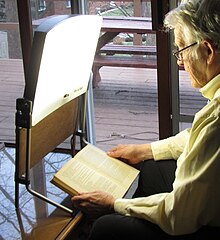| Seasonal affective disorder | |
|---|---|
| Other names | Seasonal mood disorder, depressive disorder with seasonal pattern, winter depression, winter blues, January blues, summer depression, seasonal depression |
 | |
| Bright light therapy is a common treatment for seasonal affective disorder and for circadian rhythm sleep disorders. | |
| Specialty | Psychiatry |
Seasonal affective disorder (SAD) is a mood disorder subset in which people who typically have normal mental health throughout most of the year exhibit depressive symptoms at the same time each year.[1][2] It is commonly, but not always, associated with the reductions or increases in total daily sunlight hours that occur during the summer or winter.
Common symptoms include sleeping too much, having little to no energy, and overeating.[3] The condition in the summer can include heightened anxiety.[4]
In the DSM-IV and DSM-5, its status as a standalone condition was changed: It is no longer classified as a unique mood disorder, but is now a specifier (called "with seasonal pattern") for recurrent major depressive disorder that occurs at a specific time of the year and fully remits otherwise.[5] Although experts were initially skeptical, this condition is now recognized as a common disorder.[6] The validity of SAD was called into question, however, by a 2016 analysis by the Centers for Disease Control in which no links were detected between depression and seasonality or sunlight exposure.[7]
In the United States, the percentage of the population affected by SAD ranges from 1.4% of the population in Florida to 9.9% in Alaska.[8] SAD was formally described and named in 1984, by Norman E. Rosenthal and colleagues at the National Institute of Mental Health.[9][10]
- ^ Oginska H, Oginska-Bruchal K (May 2014). "Chronotype and personality factors of predisposition to seasonal affective disorder". Chronobiology International. 31 (4): 523–31. doi:10.3109/07420528.2013.874355. PMID 24397301. S2CID 22428871.
- ^ Ivry, Sara (August 13, 2002). Seasonal Depression can Accompany Summer Sun. The New York Times. Retrieved September 6, 2008
- ^ MedlinePlus Overview seasonalaffectivedisorder
- ^ Seasonal affective disorder (SAD): Symptoms. MayoClinic.com (September 22, 2011). Retrieved on March 24, 2013.
- ^ Friedman, Richard A. (December 18, 2007) Brought on by Darkness, Disorder Needs Light. New York Times.
- ^ Traffanstedt M, Mehta S, LoBello S (2016). "Major Depression With Seasonal Variation: Is It a Valid Construct?". Clinical Psychological Science. 4 (5): 825–834. doi:10.1177/2167702615615867. S2CID 43574728.
- ^ Nolen-Hoeksema S (2014). Abnormal Psychology (6th ed.). New York, New York: McGraw-Hill Education. p. 179. ISBN 978-1-259-06072-4.
- ^ Rosenthal NE, Sack DA, Gillin JC, Lewy AJ, Goodwin FK, Davenport Y, Mueller PS, Newsome DA, Wehr TA (January 1984). "Seasonal affective disorder. A description of the syndrome and preliminary findings with light therapy". Archives of General Psychiatry. 41 (1): 72–80. doi:10.1001/archpsyc.1984.01790120076010. PMC 2686645. PMID 6581756.
- ^ Marshall, Fiona. Cheevers, Peter (2003). "Positive options for Seasonal Affective Disorder", p. 77. Hunter House, Alameda, Calif. ISBN 0-89793-413-X.